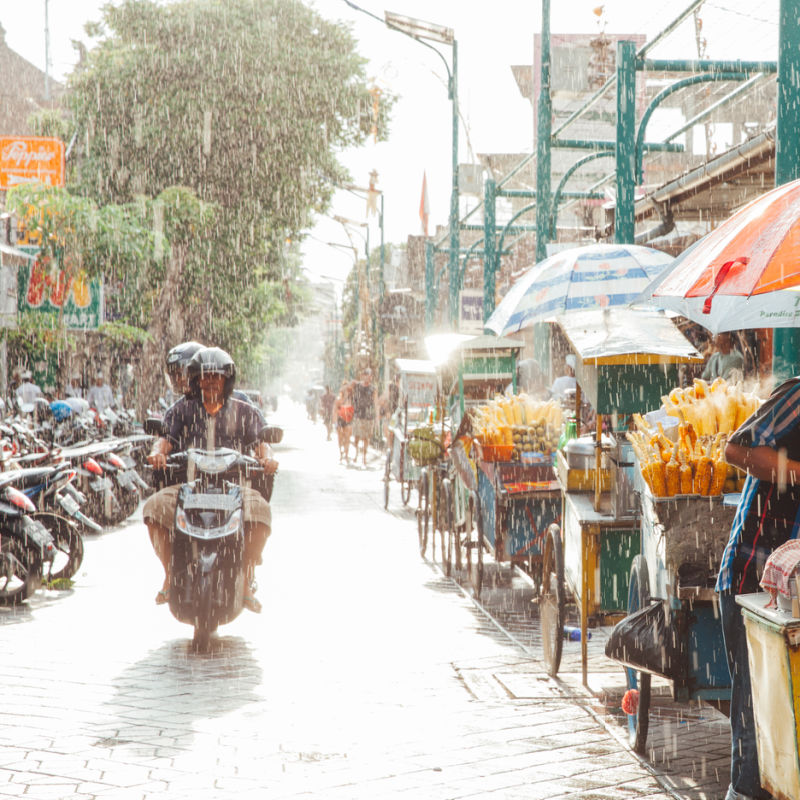Bali Weather Guide: ‘Wet’ and ‘Dry’ Season
As a retired expat originally from New York with 4 full seasons, I’ve grown accustomed to the unique weather patterns of Bali. The island experiences two distinct seasons: the wet season and the dry season.
These are my personal experiences of both seasons and offer a detailed comparison of what to expect during each one.
To save you a read, I can sum it up like this if you prefer: Bali is “hot as balls” for half of the year (April to October) and “hot as balls with rain” for the other half (November to March).
Bali Wet Season

The wet or rainy season in Bali typically lasts from November to March, with the heaviest rainfall occurring between December and February. During this time, the island is characterized by high humidity, overcast skies and frequent rain showers to crazy storms. Despite the damp conditions, the rainy season has a charm of its own. The lush, vibrant green landscapes that emerge are truly breathtaking (you can almost see it grow right before your eyes), and the slightly cooler temperatures can be a welcome respite from the intense heat of the dry season.
As a retired expat who’s experienced harsh winters for a lifetime, I’ve learned to adapt to the rainy season by engaging in indoor activities, such as practicing yoga, visiting art galleries or enjoying the island’s many cafes and restaurants. When the rain does subside, it’s the perfect opportunity to explore Bali’s stunning waterfalls, which are at their most impressive during this time. Additionally, the rainy season often means fewer tourists, resulting in a quieter, more peaceful atmosphere on the island.
Despite it called “rainy season”, it doesn’t mean it rains all the time. Yes it’s quite frequent but when it does comes down, it stops within minutes then the sun blares out drying everything as if rain never fell. However, rain is extremely unpredictable and temperamental to the likes of which I’ve never seen.
Bali Dry Season

Bali’s dry season spans from April to October, with the sunniest and warmest months being June, July, and August. During this time, the island is bustling with tourists and the weather is predominantly sunny, hot, and dry. As a former New Yorker, I relish the endless sunshine and warmth, which are a far cry from the chilly winters of my former home.
The dry season is ideal for outdoor activities, such as beach-hopping, surfing and exploring the island’s many temples. The warm weather and clear skies make for perfect sunsets, and the abundance of festivals and events during this time creates a lively atmosphere. However, it’s essential to stay hydrated and wear sunscreen to protect yourself from the intense heat.
Unlike the wildly unpredictable wet season, Bali’s dry season is incredibly predictable. Checking the weather is completely unnecessary as it’s always the same during this season. This makes planning your day and trips around the island a joy, as you’ll know exactly how the weather will be.
Each season in Bali has its own unique charm and advantages. The rainy season offers cooler temperatures, fewer tourists and lush, vibrant landscapes, while the dry season boasts endless sunshine, warm weather, and a lively atmosphere. I’ve learned to appreciate the beauty of both seasons and adapt my activities accordingly. It’s not always fun to be sweating so easily but I certainly don’t miss the freezing temperatures of winter.
Bali’s two seasons – wet and dry – offer different yet equally captivating experiences with something for everyone on this enchanting island. I’m grateful for the opportunity to enjoy both seasons in this tropical paradise.






